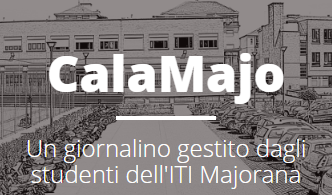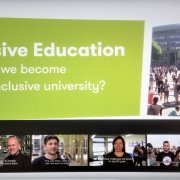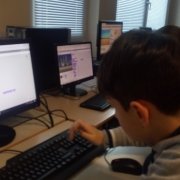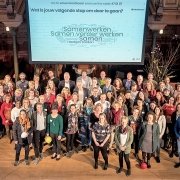CalaMajo – the video journal of the school
Excerpt
CalaMajo (means "inkwell" in Italian but it also represents "crasi" from Calamaio and Majorana - the name of the school) is a project for creating a video journal of the school by the students. The project is aimed at the recovery of basic skills and inclusion for students of our school (secondary high school). The project aims to achieve the goal with activities proposed in a new way compared to the frontal lesson, to support them in the recovery of basic Italian skills and to motivate them to study.
Narrative, origins and objectives of the initiative
What kind of project is this? Please give a short description (summary) of it.
CalaMajo is aimed at the recovery of basic skills and inclusion for the students of our school (secondary high school). The project aims to achieve the goal with activities proposed in a new way compared to the frontal lesson, to support them in the recovery of basic Italian language skills and to motivate them to study. The video journal was developed to involve them in a writing activity, the opening to the cultural spaces offered by the territory allowed them to work with the teacher and peers in a more open and colloquial manner, in pleasant contexts able to solicit self-expression and interest in the discussion topics undertaken. The cultural places then became a starting point for discussion and writing.
The idea was born to experiment with new inclusive didactics. The project is carried out through weekly meetings of two or three hours depending on the proposed activity and commitments in other homework.
The participation was proposed to the classes and the students were free to participate as an extracurricular activity.
The meetings favored inclusion because of the two techniques adopted: the flipped classroom and the peer to peer learning.
The students could choose their preferred activities: for example, the more self-confident ones have decided to act as speakers in the videos, others were responsible for shooting or video editing, and almost all of them were involved in the editorial activity.
The objectives of the project are to the increase of motivation in subjects at risk of abandonment and rejection. Among the aims of the project is to convey the sense of belonging to the school community thanks to the more informal approach in which the different activities are carried out.
Please tell us why, in general, this project is considered a successful one?
CalaMajo is considered a successful initiative for the continuous attendance in the lessons and because the students are interested in continuing the work next year; moreover, the same students have designed some changes, for example, they proposed to publish the entire newspaper online and insert inside links to the videos. None of them left school and that was a good indicator as lack of motivation in some students is one of the problems the school faced.
And why would you consider it a grass-roots initiative?
CalaMajo was a proposal by teachers to respond to the problems of learning and also to ensure the opening of the school in the afternoon in order to help the students in a healthy and constructive reality. This initiative was highly engaging because the students were free to organize their work according to their interests and thus succeed in bringing out their best attributes. Knowing that they will not be questioned or evaluated in any way allowed them to enjoy a calm, productive afternoon.
What challenges needed to be solved in this project?
The project allows young people with different problems to work together and encourage their motivation and interest in cultural activities. A collaboration with the local libraries network (SBAM) team was activated and this allowed them to access online services and thus have the opportunity to read newspapers, magazines, and novels. Moreover, a further collaboration started with the Circolo dei Lettori di Torino (https://www.circololettori.it/)
Is this initiative based on any particular theoretical framework? Which one?
The flipped classroom methodology was adopted along with a first attempt of introducing the Debate methodology.
In this context, the idea of using the flipped classroom emerged to give the students control over the activity, reversing the traditional learning environment: the students managed the contents and roles, elaborating concepts with the guidance of the teacher-mentor. The debate methodology helped in developing critical thinking, as the students played a different role in a discussion, advocating opposing positions on a topic or question in order to learn how to present their ideas and respect those of others.
(Appendix) Is your intervention standing on its own or is it a part of a bigger and more holistic approach?
Please describe the group(s) intended as beneficiaries of this initiative
Why has this group (have these groups) been chosen?
The students of the school come from Torino and the metropolitan area, including some villages like Grugliasco, Collegno, Rivoli and a more rural area (Susa Valley). They belong to a population almost without a common cultural identity, of different regional and transnational origins: a mixture of small commercial and commercial bourgeoisie, artisan class and working class. Even when the economic condition is acceptable, the cultural level is, in many cases, modest.
The target of the project are students at risk of dropping out, with rejection or multiple rejections, students with learning problem certification (DSA), gambling and computer addiction, or problematic family situations: they need informal and non-formal educational interventions and effective-relational approaches.
Could you please tell us something about the relative size of the (of each) target group, within the school/university population, region and/or country?
The school has 1240 students in total: the working group of CalaMajo consisted of 22 students from different classes and with different age; 7 girls and 15 boys. The group had a student with a disability profile (HC), two students with a learning disability and one foreign student. Three students had been reported for poor commitment and irregular attendance.
Which social characteristics are taken into account and what is the geographical area covered?
Most adolescents come from a socio-cultural context where there are often few reasons to study and where there are shortcomings in basic training due mainly to limited resources and few cultural interests. There are quite a significant percentage of students with family problems (15%) and special needs (15%) due to single parenting students or families with serious problems in the education of their children; there is a high presence of students with learning problems certification. In this context, it is an aggravating factor, compared to the risk of rejection. The presence of a large number of disciplines in the first two-year period and also the high number of teachers with whom the student is forced to confront.
On which level is the project implemented?
At the school level.
Please describe the political and socio-economic factors that you believe have been important enablers for your initiative
Did the initiative have political support?
The work project was financed with European Union funds, provided by the National Ministry through public calls. The Institute is committed to modifying its teaching methodology by creating a database of experiences gained by some colleagues and made available to all the class councils.
How did it fit with local, regional or national policies?
The funds were provided to address school drop-outs adopting inclusion practices.
Who are the stakeholders supporting the initiative?
The municipalities of Collegno and Grugliasco and civic libraries have collaborated in the development of the activity; they have made their premises and an expert available to present services offered to schools and citizens.
Are there particular demographic changes present that are influencing the project?
No.
What is the institutional strategy and culture of the (educational) organization?
The CalaMajo project fits with the strategy of the school, which is oriented to school drop-outs and supports the students with extra-curricular activities, keeping the school open and accessible in the afternoons.
To what extent does the initiative have an influence on institutional policy (or potential influence) of the (educational) organization?
This project encourages a reflection on the need to disseminate new evaluation practices and educational strategies at institutional level: they learned to be compliant with deadlines and they assessed the quality of the product in a shared process with the comrades, on the basis of a grid prepared at the beginning of the activity. No decimal evaluation was expressed as it was an extra-curricular activity. For the future, the students requested the recognition of results of this activity as a curricular activity too, but this process needs the approval of the class council teachers.
(Appendix) Is there public support for your initiative and the issue it addresses?
(Appendix) What other factors do you think have been important for the success of this initiative?
Please describe the overall initiative design and the methods and tools used to reach the goals
Please describe the specific activities carried out.
In order to produce short videos for the school magazine, some preparatory activities were needed in order to set up a recording area equipped with a green screen, desk, and microphone. Moreover, for every issue, it was necessary to have a draft, choice of topics, recording, editing, etc.
What were the key roles (teacher, student, management team etc.) within the project?
The teachers: define the goal to be achieved in each meeting respecting the execution times; Skilled students: students capable of editing videos that also trained their teammates to acquire the necessary techniques for recording and editing.
What ideas, tools, theories, models, methodology (etc.) have been used to reach the goals?
The project exploited the desire to appear and be noticed in order to stimulate the students, usually not being reactive and being apathetic to the school’s proposal. Moreover, they were divided in small groups, with the role of chief editor given to one of them.
What are the final revenues of the project?
Due to the good results of the CalaMajo project, the school plans to replicate it in the future.
Please describe if your project ensured its sustainability
If so, how did you ensure the short-term impact of the project?
The first videos were a real stimulus for the involvement, experiencing school as a space where it’s possible to feel good. A request for continuation of the activity has already been submitted with the participation to another call for funds.
And how did you ensure the long-term impact of the project?
Has your project been replicated elsewhere?
Please tell us about the resources used in this initiative
What was the budget for the initiative?
The budget was € 5,082.00 for paying teachers and administrative staff: it was a low-cost project, as it used many infrastructures already available at the school.
How much did the initiative depend on volunteers?
The initiative didn't depend on volunteers, as the teachers and other staff is paid.
How were the costs perceived by the public/the sector/other stakeholders?
To what extent did the initiative achieve its objectives?
Please describe the evidence to support the success of your initiative.
A questionnaire was distributed but the data was not yet analyzed. Nevertheless, the project raised some interest in the territory as it fosters a new model of active citizenship.
Did the intervention lead to any unintended (positive) outcomes?
What indicators (quantitative and qualitative) have you measured to demonstrate success?
The positive indicators that were used to measure the success were the attendance at meetings, the good results and improvements evaluations in the linguistic area, as well as the quality of the materials produced by the students.



 Sale für Alle 2018
Sale für Alle 2018


 Simona Cerrato
Simona Cerrato
